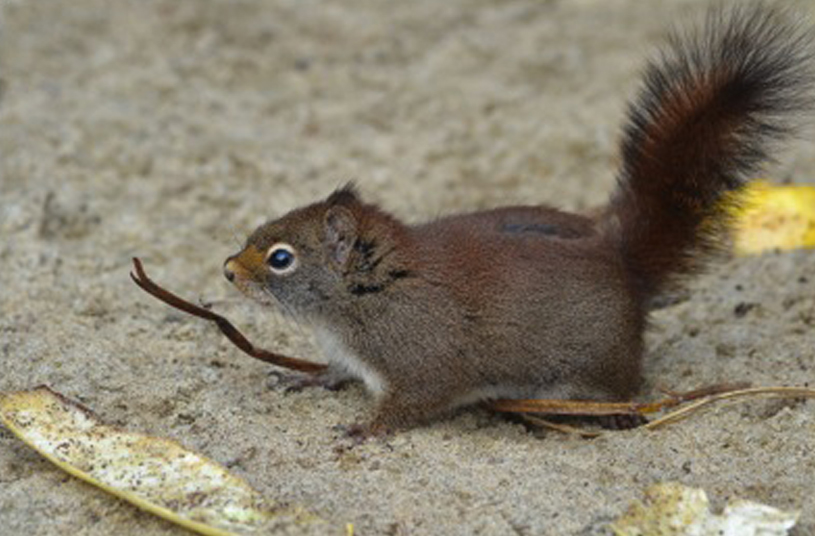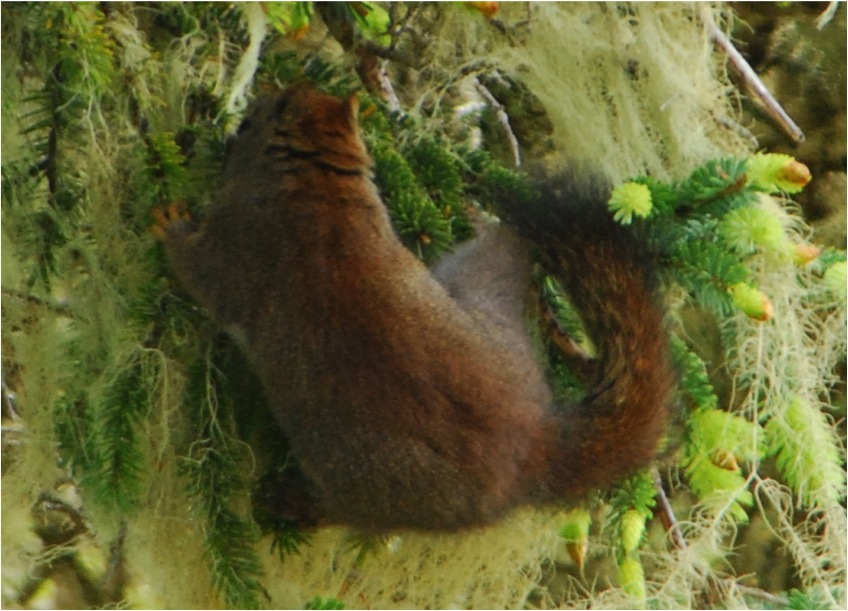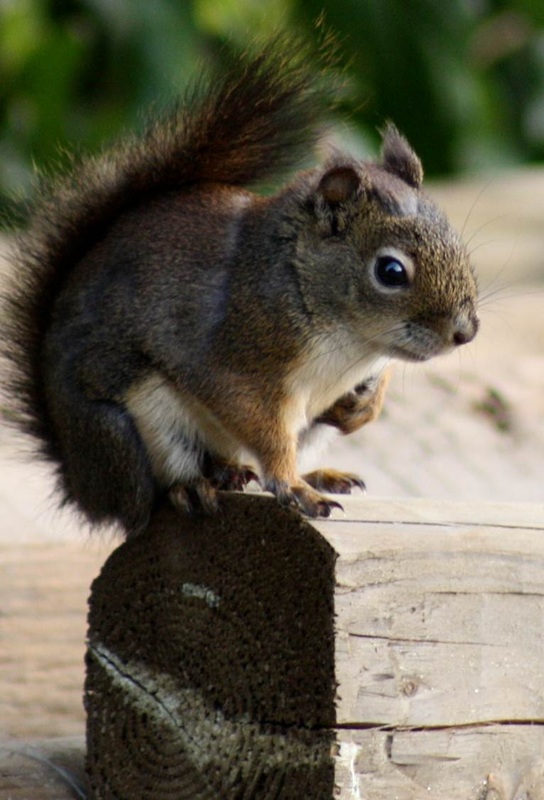Red squirrel • Tamiasciurus hudsonicus
Identification
This squirrel can be various shades of grey and red-brown to olive-brown, with a white, pale yellow, or light grey belly. The fur on its back and its bushy tail is usually tipped with red. It has tufted ears, particularly during winter, and a thick white ring around each eye. In summer a dark line often separates the lighter underside from the darker back. The red squirrel is smaller than other tree squirrel species, reaching only 23 cm long (not including its tail, which can be up to 16 cm long).
Habitat & Range
The red squirrel inhabits coniferous or mixed forests, though it does well in urban settings with significant areas of covered forest as well. Its range extends across much of British Columbia except for the southern coast, where it is conspicuously absent. This species is found in almost all of Canada, Alaska, and parts of the central and northeastern United States. Click here for a range map.
Similar Species
This is the only native squirrel species on the Central Coast, other than the northern flying squirrel (Glaucomys sabrinus), which is very different from the red squirrel. The red squirrel is much smaller than the invasive eastern grey squirrel (Sciurus carolinensis) commonly seen in urban areas such as Vancouver. The Douglas squirrel (Tamiasciurus douglasii) is generally restricted to the southern part of the province, although a few have been seen further north. In most cases its rust-coloured belly makes it easy to differentiate from the red squirrel, though the two may hybridize.
Intriguing Info
There are twenty-five recognized red squirrel subspecies, seven of which are present in BC. In the Central Coast region, specimens are likely to be T. hudsonicus lanuginosus or T. hudsonicus picatus.
iNaturalist
https://www.inaturalist.org/taxa/46260-Tamiasciurus-hudsonicus
This squirrel can be various shades of grey and red-brown to olive-brown, with a white, pale yellow, or light grey belly. The fur on its back and its bushy tail is usually tipped with red. It has tufted ears, particularly during winter, and a thick white ring around each eye. In summer a dark line often separates the lighter underside from the darker back. The red squirrel is smaller than other tree squirrel species, reaching only 23 cm long (not including its tail, which can be up to 16 cm long).
Habitat & Range
The red squirrel inhabits coniferous or mixed forests, though it does well in urban settings with significant areas of covered forest as well. Its range extends across much of British Columbia except for the southern coast, where it is conspicuously absent. This species is found in almost all of Canada, Alaska, and parts of the central and northeastern United States. Click here for a range map.
Similar Species
This is the only native squirrel species on the Central Coast, other than the northern flying squirrel (Glaucomys sabrinus), which is very different from the red squirrel. The red squirrel is much smaller than the invasive eastern grey squirrel (Sciurus carolinensis) commonly seen in urban areas such as Vancouver. The Douglas squirrel (Tamiasciurus douglasii) is generally restricted to the southern part of the province, although a few have been seen further north. In most cases its rust-coloured belly makes it easy to differentiate from the red squirrel, though the two may hybridize.
Intriguing Info
There are twenty-five recognized red squirrel subspecies, seven of which are present in BC. In the Central Coast region, specimens are likely to be T. hudsonicus lanuginosus or T. hudsonicus picatus.
iNaturalist
https://www.inaturalist.org/taxa/46260-Tamiasciurus-hudsonicus
References
American red squirrel (Tamiasciurus hudsonicus). Wildstreen Arkive. Accessed 15/01/2015.
Rubin, C. (2012). Tamiasciurus hudsonicus. Animal Diversity Web. Accessed 27/04/2013.
Tamiasciurus hudsonicus (Erxleben, 1777). Chickaree; Pine Squirrel; Red Squirrel. In Klinkenberg, Brian. (Editor) 2012. E-Fauna BC: Electronic Atlas of the Fauna of British Columbia. Lab for Advanced Spatial Analysis, Department of Geography, University of British Columbia, Vancouver. Accessed 27/04/2013.
Tamiasciurus hudsonicus range map. IUCN Red List. Accessed 27/04/2013.
Authors and editors of page
Chanda Brietzke, Kelly Fretwell, and Brian Starzomski (2016).
American red squirrel (Tamiasciurus hudsonicus). Wildstreen Arkive. Accessed 15/01/2015.
Rubin, C. (2012). Tamiasciurus hudsonicus. Animal Diversity Web. Accessed 27/04/2013.
Tamiasciurus hudsonicus (Erxleben, 1777). Chickaree; Pine Squirrel; Red Squirrel. In Klinkenberg, Brian. (Editor) 2012. E-Fauna BC: Electronic Atlas of the Fauna of British Columbia. Lab for Advanced Spatial Analysis, Department of Geography, University of British Columbia, Vancouver. Accessed 27/04/2013.
Tamiasciurus hudsonicus range map. IUCN Red List. Accessed 27/04/2013.
Authors and editors of page
Chanda Brietzke, Kelly Fretwell, and Brian Starzomski (2016).







